Abstract
The soluble hydrogenase (hydrogen-NAD+ oxidoreductase, EC 1.12.1.2) of Alcaligenes eutrophus H16 was shown to be stabilized by oxidation with oxygen and ferricyanide as long as electron donors and reducing compounds were absent. The simultaneous presence of H2, NADH and O2 in the enzyme solution, however, caused an irreversible inactivation of hydrogenase that was dependent on the O2 concentration. The half-life periods of 4 degrees C under partial pressures of 0.1, 5, 20 and 50% O2 were 11, 5, 2.5 and 1.5 h respectively. Evidence has been obtained that hydrogenase produces superoxide free radical anions (O2-.), which were detected by their ability to oxidize hydroxylamine to nitrite. The correlation between O2 concentration, nitrite formation and inactivation rates and the stabilization of hydrogenase by addition of superoxide dismutase indicated that superoxide radicals are responsible for enzyme inactivation. During short-term activity measurements (NAD+ reduction, H2 evolution from NADH), hydrogenase activity was inhibited by O2 only very slightly. In the presence of 0.7 mM-O2 an inhibition of about 20% was observed.
Full text
PDF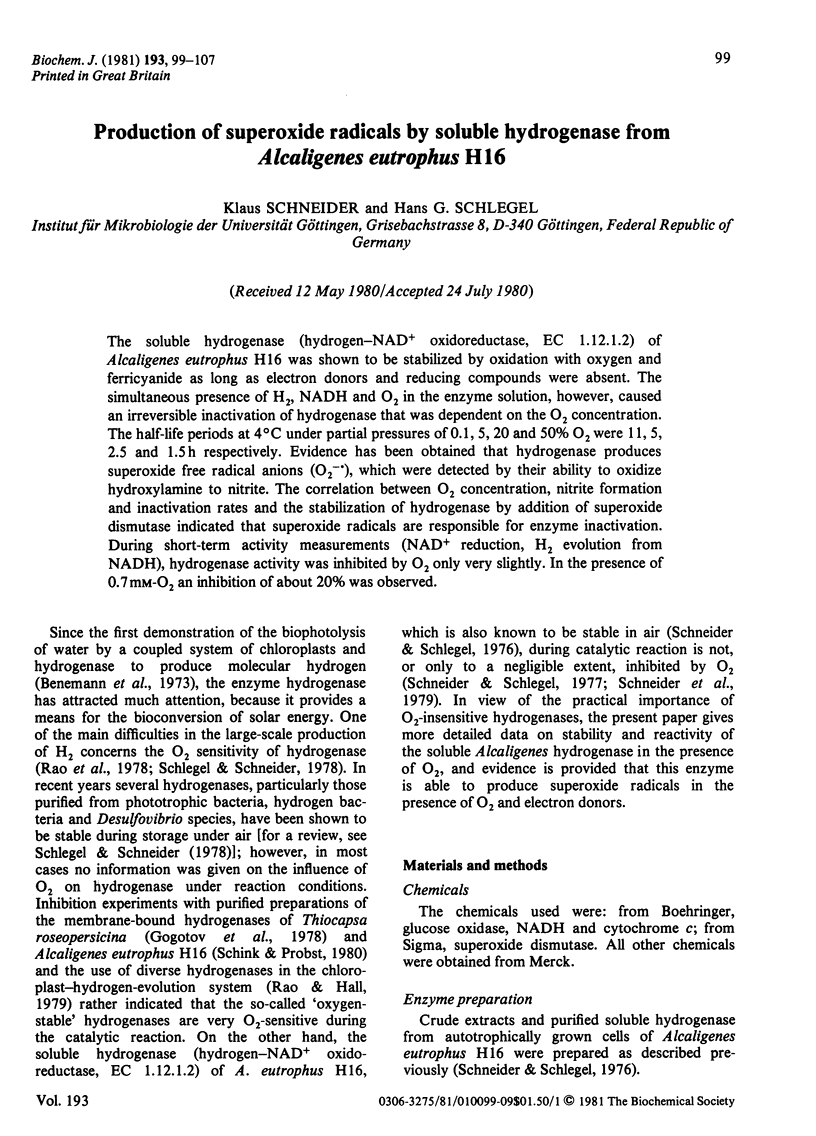
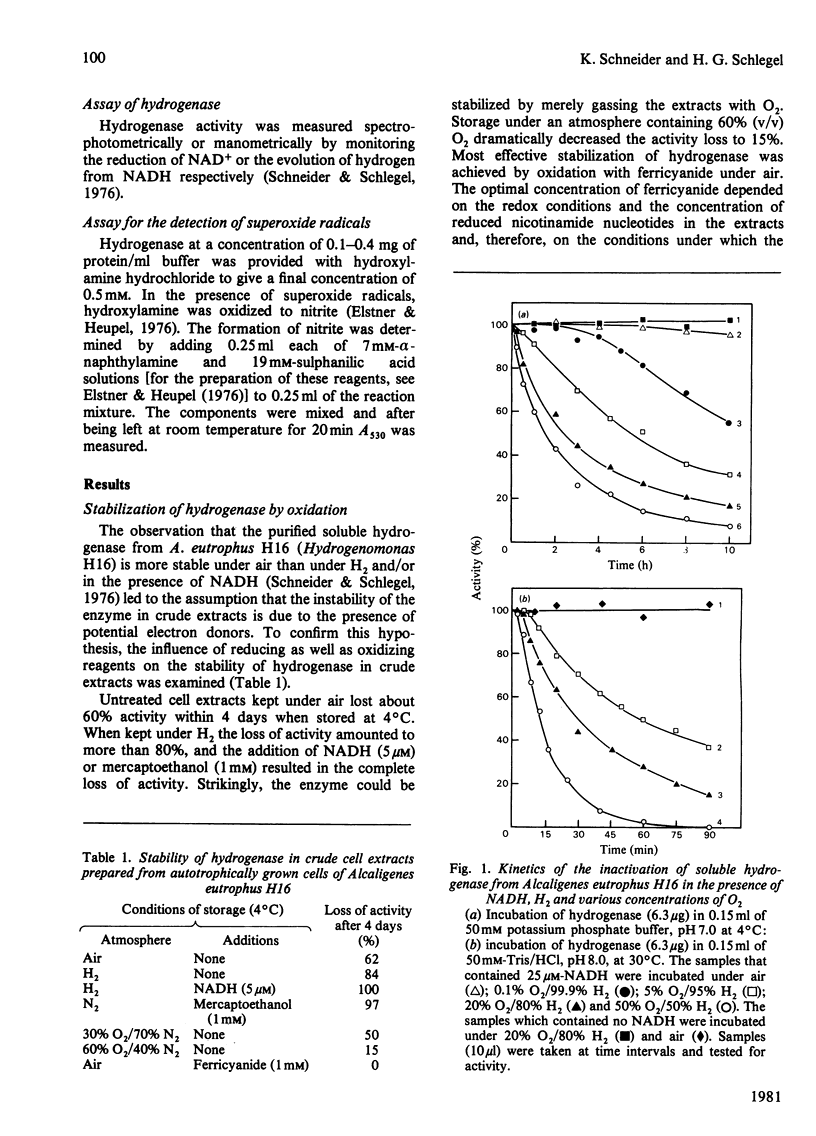

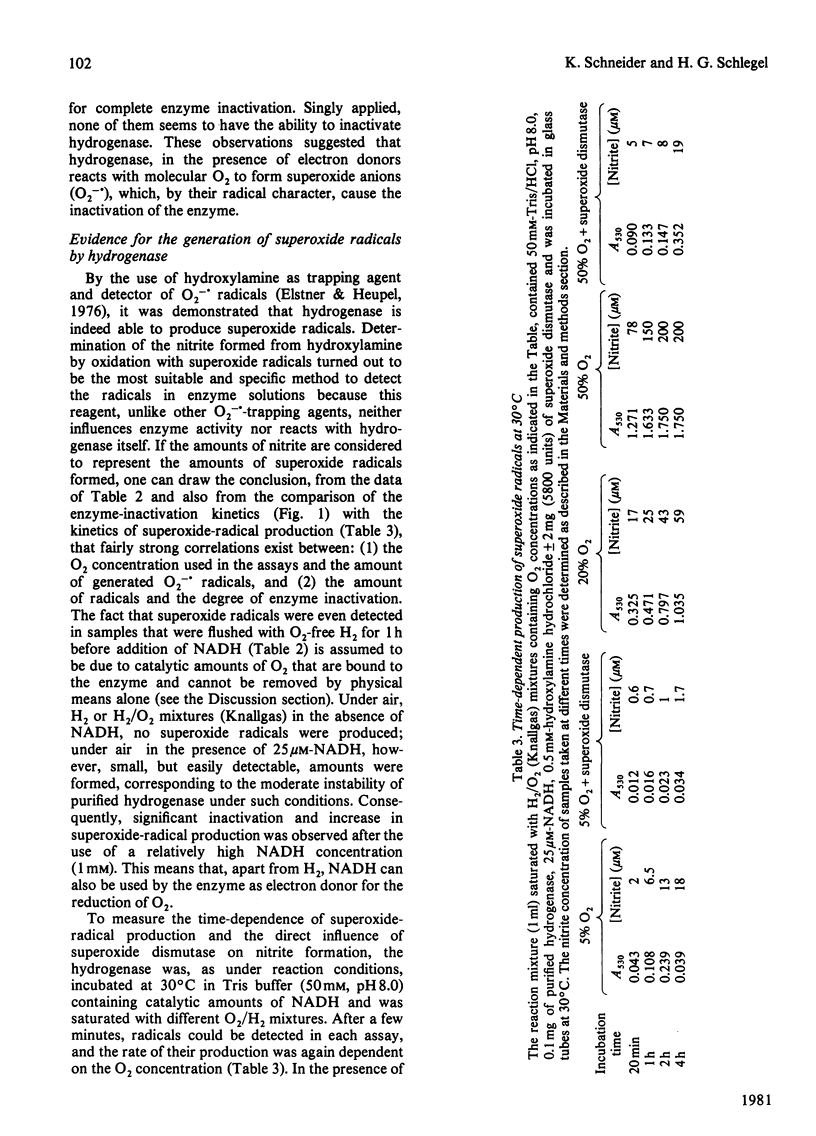

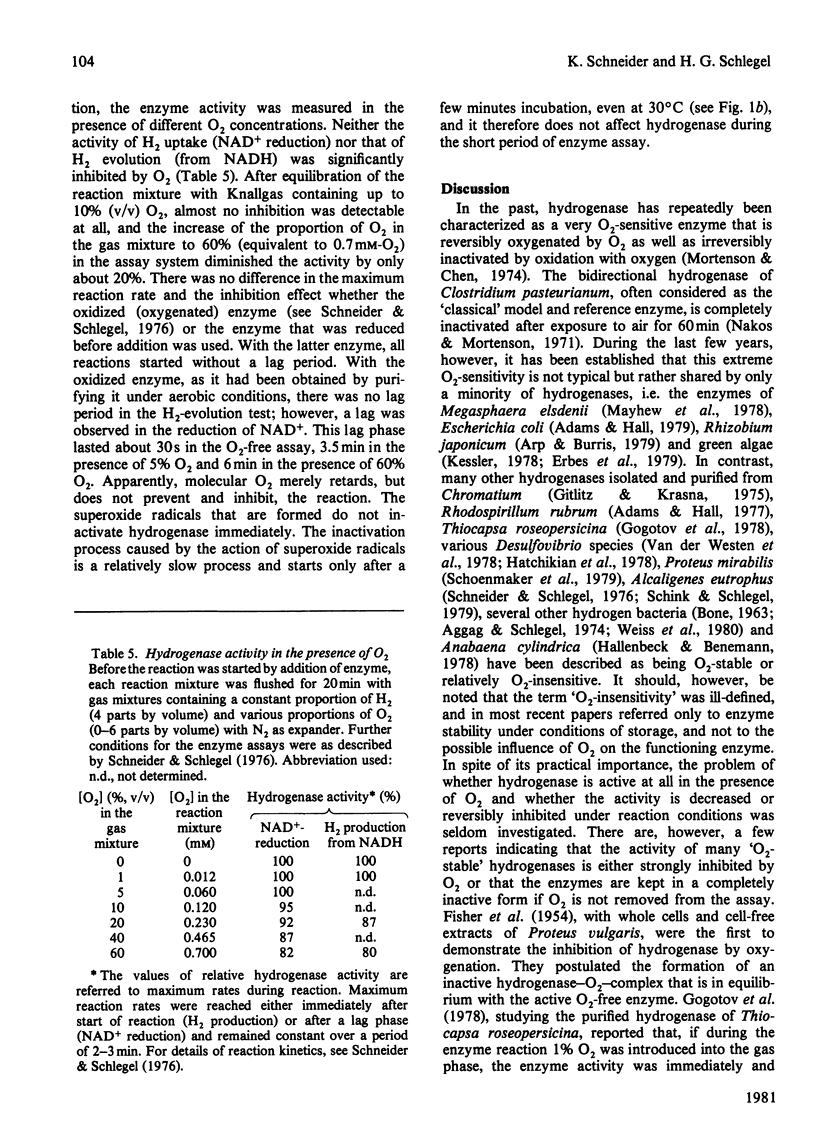

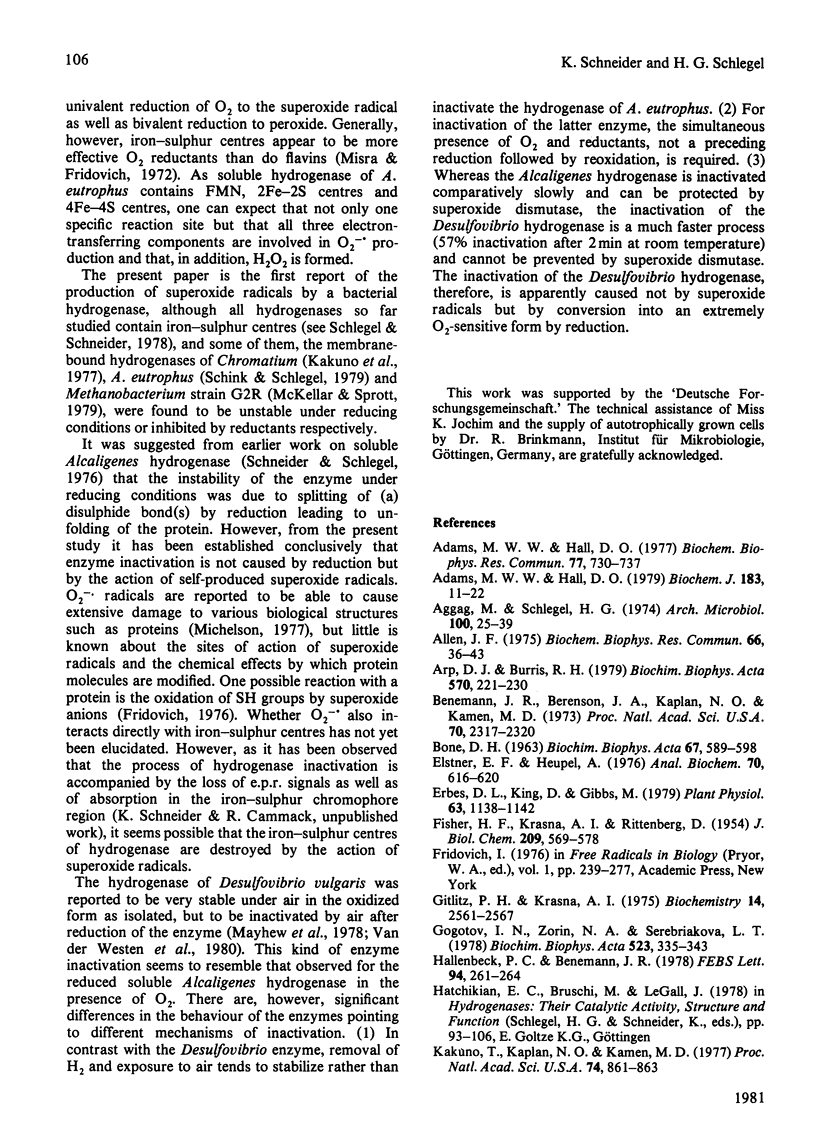

Selected References
These references are in PubMed. This may not be the complete list of references from this article.
- Adams M. W., Hall D. O. Isolation of the membrane-bound hydrogenase from Rhodospirillum rubrum. Biochem Biophys Res Commun. 1977 Jul 25;77(2):730–737. doi: 10.1016/s0006-291x(77)80039-9. [DOI] [PubMed] [Google Scholar]
- Adams M. W., Hall D. O. Purification of the membrane-bound hydrogenase of Escherichia coli. Biochem J. 1979 Oct 1;183(1):11–22. doi: 10.1042/bj1830011. [DOI] [PMC free article] [PubMed] [Google Scholar]
- Aggag M., Schlegel H. G. Studies on a gram-positive hydrogen bacterium, Nocardia opaca 1 b. III. Purification, stability and some properties of the soluble hydrogen dehydrogenase. Arch Microbiol. 1974;100(1):25–39. doi: 10.1007/BF00446303. [DOI] [PubMed] [Google Scholar]
- Allen J. F. A two-step mechanism for the photosynthetic reduction of oxygen by ferredoxin. Biochem Biophys Res Commun. 1975 Sep 2;66(1):36–43. doi: 10.1016/s0006-291x(75)80291-9. [DOI] [PubMed] [Google Scholar]
- Arp D. J., Burris R. H. Purification and properties of the particulate hydrogenase from the bacteroids of soybean root nodules. Biochim Biophys Acta. 1979 Oct 11;570(2):221–230. doi: 10.1016/0005-2744(79)90142-6. [DOI] [PubMed] [Google Scholar]
- BONE D. H. Inhibitor, isotopic and kinetic studies on hydrogen dehydrogenase. Biochim Biophys Acta. 1963 Apr 9;67:589–598. doi: 10.1016/0006-3002(63)91869-9. [DOI] [PubMed] [Google Scholar]
- Benemann J. R., Berenson J. A., Kaplan N. O., Kamen M. D. Hydrogen evolution by a chloroplast-ferredoxin-hydrogenase system. Proc Natl Acad Sci U S A. 1973 Aug;70(8):2317–2320. doi: 10.1073/pnas.70.8.2317. [DOI] [PMC free article] [PubMed] [Google Scholar]
- Elstner E. F., Heupel A. Inhibition of nitrite formation from hydroxylammoniumchloride: a simple assay for superoxide dismutase. Anal Biochem. 1976 Feb;70(2):616–620. doi: 10.1016/0003-2697(76)90488-7. [DOI] [PubMed] [Google Scholar]
- Erbes D. L., King D., Gibbs M. Inactivation of Hydrogenase in Cell-free Extracts and Whole Cells of Chlamydomonas reinhardi by Oxygen. Plant Physiol. 1979 Jun;63(6):1138–1142. doi: 10.1104/pp.63.6.1138. [DOI] [PMC free article] [PubMed] [Google Scholar]
- FISHER H. F., KRASNA A. I., RITTENBERG D. The interaction of hydrogenase with oxygen. J Biol Chem. 1954 Aug;209(2):569–578. [PubMed] [Google Scholar]
- Gitlitz P. H., Krasna A. I. Structural and catalytic properties of hydrogenase from Chromatium. Biochemistry. 1975 Jun 17;14(12):2561–2568. doi: 10.1021/bi00683a001. [DOI] [PubMed] [Google Scholar]
- Gogotov I. N., Zorin N. A., Serebriakova L. T., Kondratieva E. N. The properties of hydrogenase from Thiocapsa roseopersicina. Biochim Biophys Acta. 1978 Apr 12;523(2):335–343. doi: 10.1016/0005-2744(78)90036-0. [DOI] [PubMed] [Google Scholar]
- KUSAI K., SEKUZU I., HAGIHARA B., OKUNUKI K., YAMAUCHI S., NAKAI M. Crystallization of glucose oxidase from Penicillium amagasakiense. Biochim Biophys Acta. 1960 Jun 3;40:555–557. doi: 10.1016/0006-3002(60)91406-2. [DOI] [PubMed] [Google Scholar]
- Kakuno T., Kaplan N. O., Kamen M. D. Chromatium hydrogenase. Proc Natl Acad Sci U S A. 1977 Mar;74(3):861–863. doi: 10.1073/pnas.74.3.861. [DOI] [PMC free article] [PubMed] [Google Scholar]
- Kellogg E. W., 3rd, Fridovich I. Liposome oxidation and erythrocyte lysis by enzymically generated superoxide and hydrogen peroxide. J Biol Chem. 1977 Oct 10;252(19):6721–6728. [PubMed] [Google Scholar]
- McCord J. M., Fridovich I. Superoxide dismutase. An enzymic function for erythrocuprein (hemocuprein). J Biol Chem. 1969 Nov 25;244(22):6049–6055. [PubMed] [Google Scholar]
- McKellar R. C., Sprott G. D. Solubilization and properties of a particulate hydrogenase from Methanobacterium strain G2R. J Bacteriol. 1979 Jul;139(1):231–238. doi: 10.1128/jb.139.1.231-238.1979. [DOI] [PMC free article] [PubMed] [Google Scholar]
- Misra H. P., Fridovich I. The generation of superoixide radical during the autoxidation of ferredoxins. J Biol Chem. 1971 Nov 25;246(22):6886–6890. [PubMed] [Google Scholar]
- Misra H. P., Fridovich I. The univalent reduction of oxygen by reduced flavins and quinones. J Biol Chem. 1972 Jan 10;247(1):188–192. [PubMed] [Google Scholar]
- Nakos G., Mortenson L. Purification and properties of hydrogenase, an iron sulfur protein, from Clostridium pasteurianum W5. Biochim Biophys Acta. 1971 Mar 10;227(3):576–583. doi: 10.1016/0005-2744(71)90008-8. [DOI] [PubMed] [Google Scholar]
- Orme-Johnson W. H., Beinert H. On the formation of the superoxide anion radical during the reaction of reduced iron-sulfur proteins with oxygen. Biochem Biophys Res Commun. 1969 Sep 10;36(6):905–911. doi: 10.1016/0006-291x(69)90289-7. [DOI] [PubMed] [Google Scholar]
- Rao K. K., Gogotov I. N., Hall D. O. Hydrogen evolution by chloroplast-hydrogenase systems: improvements and additional observations. Biochimie. 1978;60(3):291–296. doi: 10.1016/s0300-9084(78)80825-6. [DOI] [PubMed] [Google Scholar]
- Schink B., Schlegel H. G. The membrane-bound hydrogenase of Alcaligenes eutrophus. I. Solubilization, purification, and biochemical properties. Biochim Biophys Acta. 1979 Apr 12;567(2):315–324. doi: 10.1016/0005-2744(79)90117-7. [DOI] [PubMed] [Google Scholar]
- Schneider K., Cammack R., Schlegel H. G., Hall D. O. The iron-sulphur centres of soluble hydrogenase from Alcaligenes eutrophus. Biochim Biophys Acta. 1979 Jun 19;578(2):445–461. doi: 10.1016/0005-2795(79)90175-2. [DOI] [PubMed] [Google Scholar]
- Schneider K., Schlegel H. G. Identification and quantitative determination of the flavin component of soluble hydrogenase from Alcaligenes eutrophus. Biochem Biophys Res Commun. 1978 Oct 16;84(3):564–571. doi: 10.1016/0006-291x(78)90743-x. [DOI] [PubMed] [Google Scholar]
- Schneider K., Schlegel H. G. Purification and properties of soluble hydrogenase from Alcaligenes eutrophus H 16. Biochim Biophys Acta. 1976 Nov 8;452(1):66–80. doi: 10.1016/0005-2744(76)90058-9. [DOI] [PubMed] [Google Scholar]
- Schoenmaker G. S., Oltmann L. F., Stouthamer A. H. Purification and properties of the membrane-bound hydrogenase from Proteus mirabilis. Biochim Biophys Acta. 1979 Apr 12;567(2):511–521. doi: 10.1016/0005-2744(79)90137-2. [DOI] [PubMed] [Google Scholar]
- van der Westen H. M., Mayhew S. G., Veeger C. Separation of hydrogenase from intact cells of Desulfovibrio vulgaris. Purification and properties. FEBS Lett. 1978 Feb 1;86(1):122–126. doi: 10.1016/0014-5793(78)80112-4. [DOI] [PubMed] [Google Scholar]


